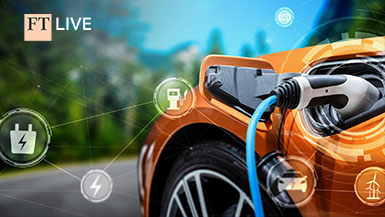THE FUTURE IS ELECTRIC (SUSTAINABILITY SERIES #2)
This is the second article in a series that aims to illuminate how innovative technological platforms and software solutions are enabling cleantech and invite dialogue with others on the future of energy and sustainability. See here for Article 1.
THE ELECTRIFICATION MEGATREND
From cars to home heating to industrial processes, electrification is the megatrend taking the planet by storm. Each of these end applications requires infrastructure powered by a single sector—electricity. The push to electrify everything is accelerating through a combination of regulation, consumer pull, and a general ethos around sustainable practices.
Electrification calls for reimagining how we refuel our cars, heat and cool our homes, and power our industries. As the world transitions toward sustainability, technological advancements in electrification are enabling renewables (like solar, wind, and hydro) to become viable, low-cost alternatives to traditional fossil fuel sources of power (like oil, gas, and coal). Furthermore, as the grid evolves, the distribution and management of electricity are changing. Localized pockets (called microgrids) are forming with tightly coupled energy storage capacity, and this further exacerbates the challenge to deliver electricity reliably to all users in the presence of the tremendous growth of electric vehicles (EVs). From a technology perspective, the distributed nature of assets like cars, homes, and manufacturing sites is giving rise to the Intelligent Edge where analog sensing meets digitalization. Simply put, we need intelligence everywhere: at every vehicle component, every sensor, every actuator, every storage system, and every metering point.
Data is the lifeblood of this new technology world. To create and capture value, technology developers like ADI must interact in new ways throughout the ecosystem. Our focus is to learn and co-create, as we develop complete subsystems at the Intelligent Edge with our partners. As we grow, we are bringing in new expertise, in areas that stretch beyond the typical approaches into areas like artificial intelligence, data science, virtualization, battery chemistry, and more. Plus, we are advancing our IP strategy to include systems and standardization to drive the industry. In taking a holistic view of intelligence at the edge and in designing with the total cost of ownership in mind, we are enabling the Intelligent Edge to stretch into the key area for value creation and growth for the foreseeable future.
Historic Convergence Driven by Sustainability
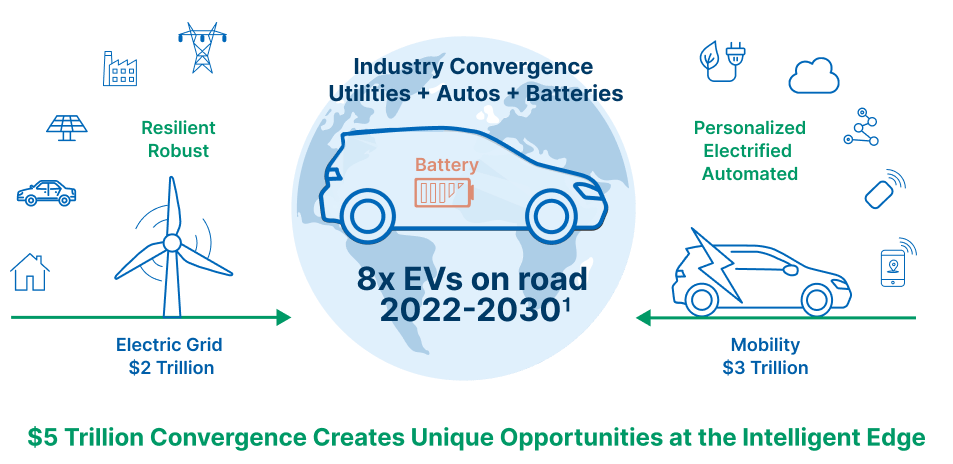
THE ROLE OF POLICY
A major tailwind to electrification is the changing regulatory environment. The Inflation Reduction Act (IRA), the Infrastructure Investment and Jobs Act (IIJA), CHIPS, the Next Generation EU (NGEU)—these days it seems like the climate policy landscape is a bit like alphabet soup, and the tailwind for domestic and international action has never been greater. Legislative innovation is aiming to accelerate the clean energy industry and encouraging private sector investment that advances global decarbonization.
In the U.S., the IRA provides $370 billion to confront the climate crisis by expanding tax credits for clean energy and EVs, boosting energy efficiency, and much more.2 The IRA, coupled with investments provided through the bipartisan IIJA, are key domestic policies aimed to help the U.S. unleash clean energy and drive down greenhouse gas (GHG) emissions. At the same time, licensing and regulatory hurdles exist at the state level for new infrastructure, and this presents a major challenge to quick growth of the grid.
Ambitious legislation to accelerate the clean energy economy is not limited to the U.S. In Europe, to achieve the goals set by the European Green Deal, the EU Commission has pledged to mobilize at least €1 trillion in sustainable investments over the next decade.3 In fact, 30% of the EU’s multiannual budget (2021 to 2028) and the EU’s NGEU instrument have been allocated for green investments.3
Industrial support, together with federal spending, is critical to truly realize these ambitious goals. Since 2015, the annual global investment in renewable energy, energy efficiency, and other transition-related technologies has steadily increased4 and reflects the growing recognition of the climate crisis.
Anticipated Capital Investment in Electrification Technologies
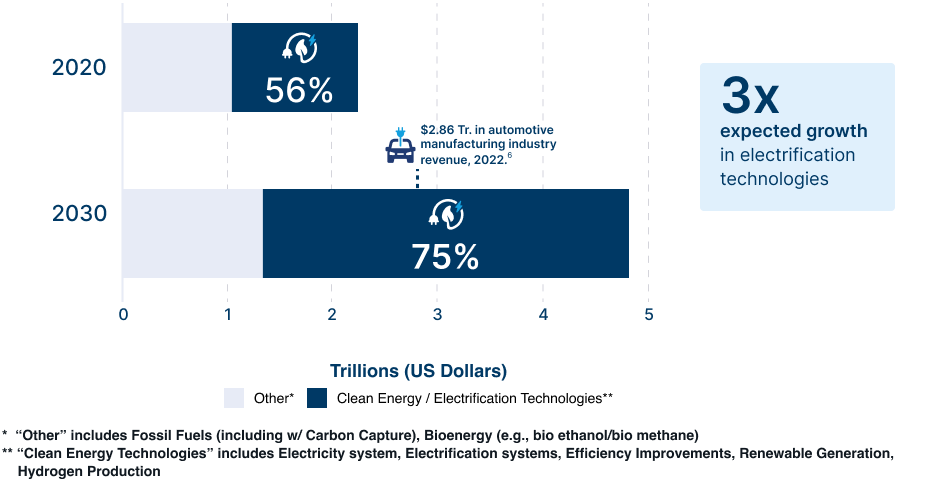
IMPLICATIONS OF THE EV REVOLUTION
The EV revolution is a key driver of the growth in the electrification market, with passenger electric cars surging in popularity. We foresee the number of electric cars on the road to exceed over 125 million by 2030, in line with the IEA’s New Policies Scenario.1
Global EV Stock
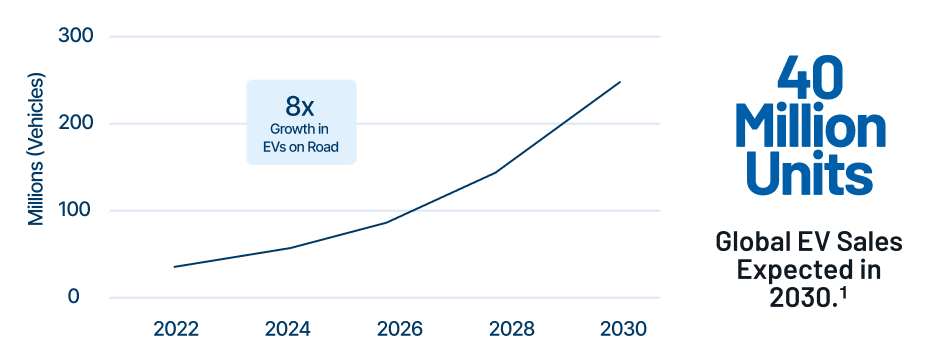
The rise of EVs has a major impact on the requirements for how the electric grid is managed. A primary consideration is the electrical load. The maximum load from this anticipated volume of electric cars is about 10 TWh. While small compared to the expected growth in global electricity production, this load is uniquely dynamic as EVs move in time and space within the energy grid’s infrastructure. The grid must possess the capacity to handle the EV load AND the ability to be managed in real-time. This is necessary to deliver power seamlessly and with zero interruption to the broader set of devices connected to the grid.
On the other side of the charging cable, sophisticated secondary substation intelligence is needed to ensure reliable energy delivery and grid management. ADI expects precision measurement, control, and real-time signal processing equipment to become the new standard as the electricity grid decentralizes and as new energy sources and loads are added. Accurate measurement of electrical power is increasingly important so as to not compromise the integrity of the network. One grid management solution experiencing increased adoption is the smart metering device. In fact, in fiscal year 2022, ADI delivered more than 28 million smart metering ICs. Innovations that deliver superior edge insights and predictive control capabilities to a new generation of smart meters would improve energy utilization, quality, health, and life of the increasingly decentralized grid.
Analog Devices takes a holistic approach to the clean energy ecosystem by leveraging its leadership in battery, power, and energy management to accelerate the transformation and convergence of two major sectors—automotive electrification and the energy grid.
ADI’s electrification portfolio, ADI Recharge™, includes battery management systems (BMS), inverters, energy storage systems (ESS), and meters. These are among the semiconductor solutions with the potential to unlock massive GHG reductions, as introduced in Article 1 (“The Future of Energy, Cleantech, and Sustainability”) of this series. If sustainable end applications like these were adopted and fully scaled, the magnitude of potential carbon impact that we, in collaboration with our customers, can potentially enable is roughly 16 Gt.5 This magnitude motivates us to work with our customers to accelerate the adoption of existing technology and to cocreate with them on breakthroughs that could change end market ecosystems.
Electrification Ecosystem
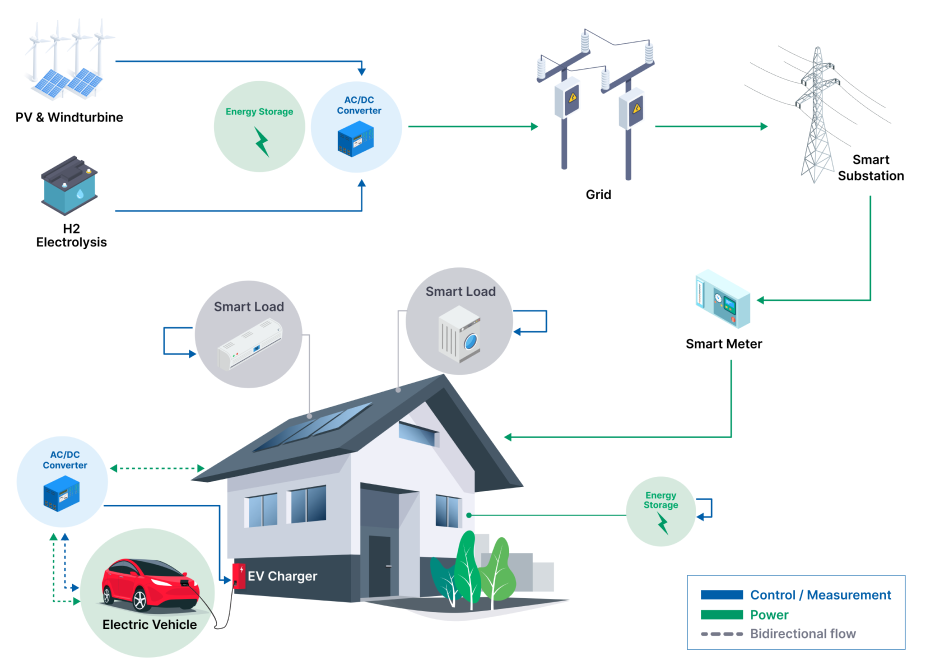
The pace of ADI collaboration with customers at their system level is stronger than ever. An example is ADI’s BMS platform, currently deployed in 16 of the top 20 global EV OEMs. Building upon the platform, today ADI is working with many OEMs, Tier 1s, battery manufacturers, energy utility companies, and other stakeholders to develop an information ecosystem from EV battery data that has never been previously possible.
Enabled by technology advancements, renewable energy sources like wind and solar now cost less than traditional sources and will continue to comprise a growing portion of electricity generation. Long term, we expect strong long-term growth in renewables, battery energy storage systems, EV charging infrastructure, electrolyzers, and heat pumps. The far-reaching nature of these assets means not only will the automotive sector benefit from electrification, but the power and industrial markets as well.
Furthermore, the role of functional safety has never been more important. Functions once considered standard are now safety critical. For example, consider the dashboard in your car. Traditionally, only speed, fuel, or engine information was displayed. Today’s dashboards contain far more information, including cameras around the vehicle, which contain safety information. The implications are big: not only must the rearview camera itself be functionally safe, but so must the display to deliver that information to the driver. We see power as the major control point for safety in the system, and we have invested to become the leading supplier of functionally safe PMICs in the industry. In fiscal year 2022 alone, ADI delivered more than 1 billion units of safe power management ICs.
INTELLIGENT EDGE OF ELECTRIFICATION
Based on our 58 years of history, Analog Devices has unparalleled capabilities for precision measurement. And as we look ahead, we are going further. In fact, we are synthesizing the ADI Recharge™ portfolio into three platform areas, which we call the Intelligent Edge for electrification. Each platform area corresponds to how we can interact with energy in the ecosystem: energy management, power conversion, and energy storage.

The data starts with precision measurement. In fact, without such measurement, data does not exist. It is the measurement process itself that creates the data. This analog area, which we call the “Edge of the Edge,” is where typical analog-centric systems start and stop. Moving up the graph, the next layer is where we focus on the Intelligent Edge. At this layer, functions are performed closer to analog, moving the value out of the centralized controller. Such functions include data processing, cell monitoring, real-time safety loops, and battery insights. Interaction with the Intelligent Edge system is provided through the ADI’s BMS API to the central controller, which supports either wired or wireless BMS.
The value shift is significant. For example, battery insights can enable real-time optimization of the charging system, and can ensure real-time safety of battery cells before, during, and after driving. Access to data stored in the cloud can be provided by keys that can be sold for each customer, each data type, or each access as a subscription fee.Many business models are possible. And as we accelerate our development, the approach in how we go to market, and interact with customers with new business models that capture value for ADI is foundational to how well we will achieve our aspirations for the Intelligent Edge.
CHARGING AHEAD
As we look ahead, we see the global decarbonization trend is not only good for the planet, but it’s also good for business. Sustainable solutions from ADI are an opportunity and a revenue driver for both us and our customers. Reliable, low power technology on both sides of the plug—powered by semiconductors—is the path to develop the Intelligent Edge.
There is no time to waste and with the signs of climate change all around us, a combination of innovative technology and legislation is helping us to electrify and ensure a brighter and healthier future for us all. At ADI, we look forward to engaging with the full electrification ecosystem to help realize its decarbonization potential.

References
1Global EV Outlook 2023: Catching up with climate ambitions (windows.net)
2 Inflation Reduction Act Guidebook | Clean Energy | The White House
3 Finance and the Green Deal (europa.eu)
4 Net Zero by 2050—Analysis—IEA
5 ADI analysis based on internal calculations assuming sustainable end applications is fully adopted and scaled. Additional study is needed to account for end products’ full life cycle
6 Automotive industry worldwide - statistics & facts | Statista
Forward Looking Statements
This article contains forward-looking statements that are subject to the safe harbors created under the Securities Act of 1933, as amended, and the Securities Exchange Act of 1934, as amended. All statements other than statements of historical fact are statements that could be deemed forward-looking statements. Read more >>



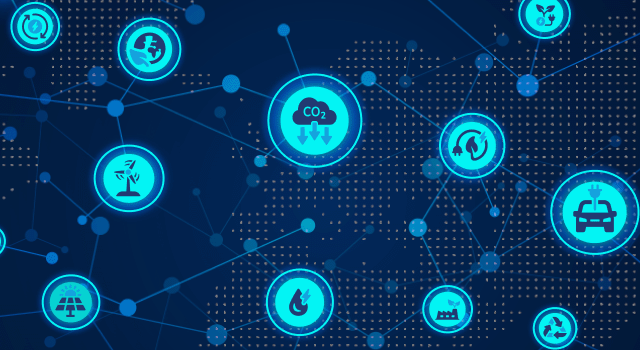


 Close Details
Close Details

